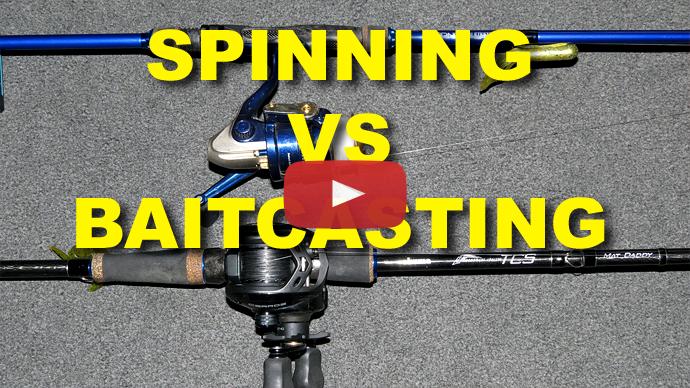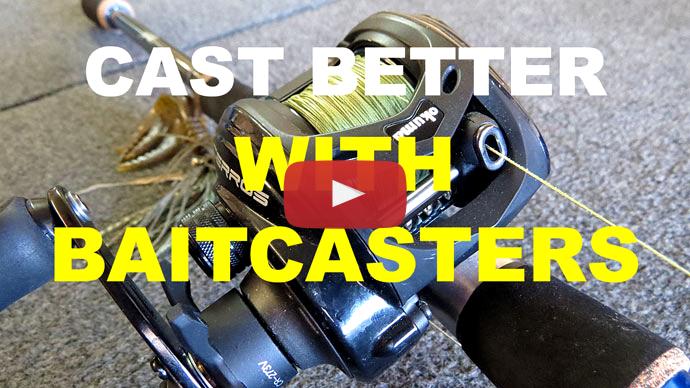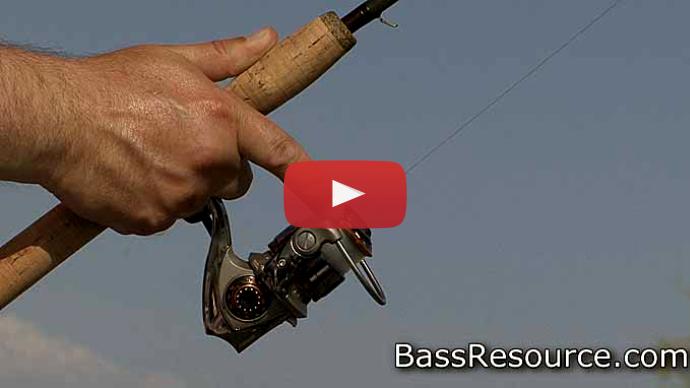You know, advancements in technology over the years have really affected bass fishing, and improved in many different ways. And reels are no different. There's been a lot of big improvements in recent years. Things like the frames that they're made out of, and the materials that they use, and how they're made, to the inner workings, the gears, the drag system, the washers that they use, you know, and the braking systems, there's been a lot of advancements. But still, you need to know when to use a baitcasting reel versus a spinning reel. There's not one that's gonna work for every situation out there. And sometimes there's a little gray and, you know, like, which one should I use? Which is best? So I'm gonna walk through some of that today and help you figure that out.
Let's talk about baitcasters, first of all. You know, baitcasters, the big thing about them is backlashes, right? The newer ones out there now have really good systems for preventing backlash. They've got magnetic brakes, and a variety of different braking systems down there with working combinations can almost eliminate backlashes. They still does it. You can still backlash them, especially if you back off on all the brakes, but they're much improved now compared to the round reels we used to use way back when.
Back in the '80s, you know, I think everybody, they had the Abu Garcia 4,600C, like, that was the mainstay. Everybody had those on those rods, I think I had 10 of them on my rods at the time. But they only had one mechanical-type brake on them, which was okay, still worked, but your thumb was your main braking system. And if you go further back when I was a kid, I wouldn't date myself, but baitcasting reels didn't have any brake in them at all. The only way you prevented backlashes was with this, and practicing with your casting so you didn't overpower the reel. So, you've got this.
If you've never thrown a baitcaster, you're just learning, you've got this. They've got the tools now built into these newer reels to be able to control them so you don't have any massive backlashes anymore. So that's a huge improvement. But even the shape of the baitcasters is good now. You know, they're the low-profile reels, they feel really good in the palm of your hand, it allows for easier control of both casting, and when you're controlling the lure, and controlling the fish, you know, as you're bringing them back to you. So the newer reels definitely, even the cheaper reels out there, the less expensive ones are, head and tails, better than a lot of the more expensive reels from 15 years ago. They've just advanced that well.
So you don't have to buy the most expensive reel out there to get these benefits. For spinning reels, there's been a lot of advancements with those too. Now, the thing about spinning reels that's real different with baitcasters is that the spool is stationary and the line peels off in loops. And that is a significant advantage when you're throwing lighter lines and lighter lures, you don't have to worry about backlashing, and you can throw them greater distances. So it does a better job of handling that. So they're more suitable for those finesse-type situations.
But also just the improvements, again, just like the baitcasting, the frames that they're made out of, they're lighter, they're more sensitive, the gears are better, the drag systems are superior. Spinning reels have a superior drag system than baitcasters, hand down, because the disc themselves are larger, just by virtue of that, there's most surface area, so they're smoother. And you're gonna need that with lighter lines, and lures with little hooks.
You need a really smooth drag system that you can rely on. But they've even made other improvements. For example, the roller bearing, this is where the line goes through as it's being wound back on to the spinning reel. Years ago, you'd have to replace those every now and then. They'd wear out, the line would create a groove in that roller bearing. Well, today, the materials that they're making out of like titanium, you know, they're impervious to that. So you don't have to worry about that anymore. Even the cheaper reels today have great roller bearings, have great gears. Again, you don't have to spend a whole bunch of money to get a quality spinning reel.
The big difference here is with the gear ratios. With spinning, the gear ratio is determined, not only just by the gears like you have in baitcasting, but also the size of the spool. You see that they come in a lot of different sizes. For bass fishing, the recommended size is a size 2,000 or 2,500. Some manufacturers will call them a size 20 or 25, it's the same thing. But the larger the spool, will change the amount of how much line is brought in per turn of the real handle even if the gear ratio is the same, say comparable on a baitcasting.
Keep that in mind, you're actually gonna bring in the lure a bit faster with a larger size spool. The larger size spool too, it gets to an inflection point where when you're throwing these lighter lures, the larger spool, like a size 3,000 or more can actually become a hindrance. It actually has a lot of, for lack of a better word, friction that can inhibit distance for lighter lures. So that's why you want a smaller one. So kind of keep that in mind.
Spinning reels are notorious for having line twist issues. Guys, I've been fishing spinning reels for decades, and I can't remember the last time I had line twist issue. I really can't, I'm being honest. And that's because there's a lot more to it than how you spool the line on the reel. Which a lot of people think that's the answer.
If you load it correctly onto the reel, your line twist issues are solved. That's one of six different things that can affect line twist. I've got a video that goes into full detail on how to prevent line twists, and if you follow those, you will never have line twists again, I promise. I'm not gonna get into that here. But you can have tangle-free use. A lot of guys will not use spinning gear because of line twists, well, follow those steps, you won't have line twist issues. So that's not a reason to not use spinning reel.
Now, as far as choosing which reel to use for what, it used to be a really easy, easy solu... You know, you would go, okay, if the pound test is greater than 10 pound, use baitcasting, because it handles thicker, stronger line, better than spinning. And conversely, if it was 10-pound tests are lower, use spinning because it does a much better job of handling lighter lines. Baitcasting, you have actually more backlashes and other issues with lower pound test line. Unfortunately, that's changed because nowadays, you've got braided line that can be 20-pound tests, but it's super thin. In fluorocarbon line, they've got much smaller diameters. So you can't go off a pound test anymore.
What makes things even more difficult is some manufacturers measure the diameter in inches, while as others, it's in millimeter, so it's hard to compare the two. So as a general rule, you'll find on packaging they will say comparable line diameter. So, it may be 25, 30-pound braid, but the line diameter might be 8-pound line diameter. So, go off of that. If it's 10-pound or less line diameter, go with spinning. If it's above that, go with baitcasting. It's a matter of what type of reel handles and manages the line better than the other. Again, smaller diameter, lighter pound line, spinning reels handle much better. And conversely, baitcasters are better designed for heavier line. Another thing to think about is also ease of use.
Spinning, for example, if you wanna cast and skip baits under docks, and under trees, and under limbs, and under things, it's a lot easier to skip baits with a spinning outfit than with baitcasting. Not that you can't do it with baitcasting, you can, but it takes a lot more practice. And if you're just getting into bass fishing, it's a lot easier to learn spinning than baitcasting. So that's a really good, you know, reel to get off and going. But once you start to get more advanced and learning more and more about fishing, and expanding the type of lures you're using, stick to the guidelines I just gave you. And it's better with, you know, finesse tactics, that sort of thing, fighting the fish, you got the drag, castability, those lighter fluorocarbon lines, and lures are best design for spinning outfits.
The thing about using both of them is practice makes perfect. And the cool thing about this is, the one thing in bass fishing you can do when you're not on the water, and that is practice casting. Yeah, if you live in an apartment, or a condo, or something, and you don't have a backyard to practice in, go to a local park and you can practice. There's several different, not just overhand cast, but sidearm cast, underarm cast, pitching and flipping, things like this.
Now, I used to practice pitching and flipping in my living room. I just set up targets, and try to get up underneath a chair or something like that, but longer pitches are harder. Plus, the best way to practice pitching and flipping, in my opinion, is get up on a bucket or stand up on a bench so you're elevated, so you can do this better. It's hard to do this in the living room without the tip of your rod touching the floor. The thing is when you're out there at a park doing this, you always get that Yahoo that comes along and says, "Hey, you catching any, ha-ha-ha?"
I lived in an apartment for a long amount of time, and I did a lot of practicing in parks, so I had my share of ridicule, but it really did improve my casting. And if you talk to any pro out there who's really good at... Actually, they're all really good at casting, not who's good, they're all, like, amazing at using these tools. They'll all tell you they spent a lot of time off the water practicing. And that's the key to mastering both baitcasting and spinning. Both of them serve a purpose in your arsenal.
The baitcasting, they're great for the heavier lures and the stronger line, like I mentioned. But also, some of the situations, for example, when you're flipping and pitching into thicker cover, the lower gear ratios is what I like to use for two reasons. One, you don't have to bring a lure back really fast. So a lower gear ratio or high gear ratio isn't necessary. However, a lower gear ratio has a lot of torque to it and it acts like a winch. And when you're trying to horse a fish out a thick cover, that's what you need, a lot of power.
So a lower gear ratio, and flipping and pitching is ideal. Conversely, if I'm doing a lot of buzzbait fishing, or a fast spinnerbait, or a fast crankbaits, you're gonna leave me a lipless crankbait and burning it just under the surface, a faster gear ratio is necessary because you're gonna get fatigued. If you got a low gear ratio reel, and you're, "I didn't like this all day long trying to make it go fast," man, you're gonna get tired in a hurry. Your forearm's gonna hurt, your elbows, your wrists. So a faster gear ratio makes life a lot easier, you just can whine like this, and you can burn them right back real fast without all that fatigue. So gear ratio has a lot to do with the style, and the lure, and the technique that you're using, match it accordingly.
Slow-moving baits, when you're doing finesse fishing, really slow with your spinning gears. A lower ratio spinning gear is just fine, you don't need to burn back a finesse worm. And if you've mismatched it, now, you might be working a lure too fast. If you've got a fast gear ratio and you need to move it really slow, it's really easy to overwork that bait if you've got too high of a gear ratio. So keep that in mind when you're determining between the two.
The key thing is you have to use both. The best Bass Anglers in the world are very skilled at using both baitcasting and spinning. If you only use one or the other because for some reason you don't like the other, you really are limiting yourself. It's not that you cannot cast all baits with one, but you can do a better job, better presentation, better control, especially in the wind and other adverse conditions using the correct tools for the presentations that you're trying to do. You'll actually be a better angler if you master both types of reels, I promise you. So definitely get them out there, try them, match them the way I told you, practice a lot, and you're gonna become a much better angler. Hope that helps.
Wait, hold on, if you watched this video this long, then you for sure wanna watch one of these two videos here. This one here, this is the one I recommend that you watch next. This one over here, this is what YouTube thinks you should watch next. Either way, I'm in both videos, so I'll see you in a couple of seconds.



